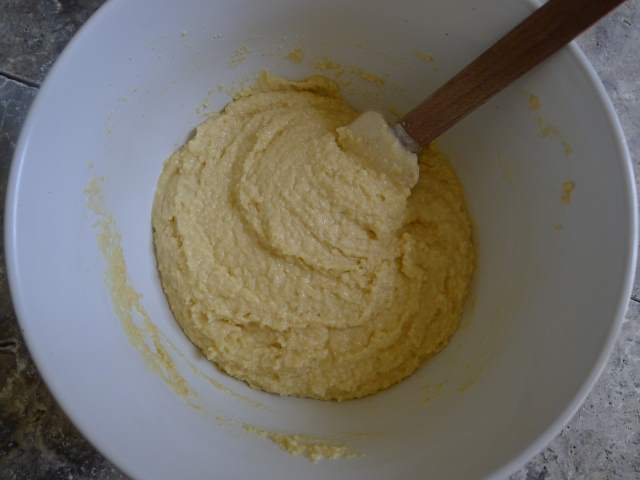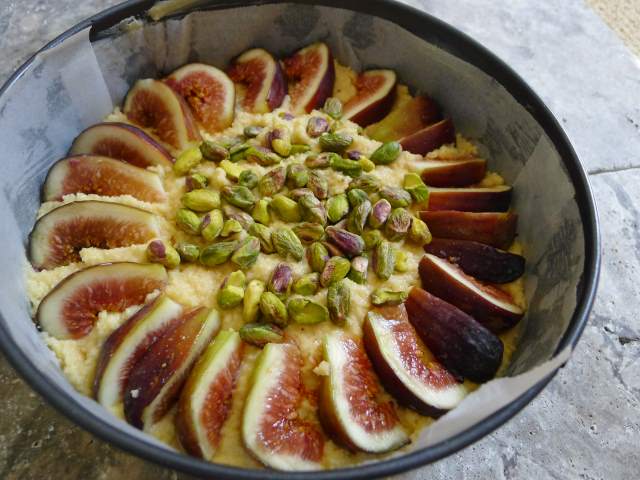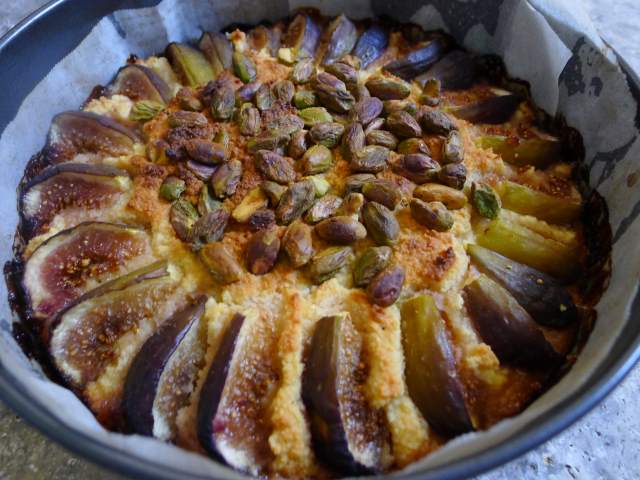 I’ll make a deal with you. First I’m going to have a little natter about getting back into the swing of hosting after a long hiatus. Then I’m going to have a small rant. Lastly I’m going to share a charming (though a touch earnest) flourless almond cake with you- here it was deployed with figs and pistachios, but could easily be tweaked depending on the season and theme of your supper (plums, peaches, apricots, pears, raspberries, blackberries, hazelnuts, pecans and walnuts would all be worthy candidates for substitution).
I’ll make a deal with you. First I’m going to have a little natter about getting back into the swing of hosting after a long hiatus. Then I’m going to have a small rant. Lastly I’m going to share a charming (though a touch earnest) flourless almond cake with you- here it was deployed with figs and pistachios, but could easily be tweaked depending on the season and theme of your supper (plums, peaches, apricots, pears, raspberries, blackberries, hazelnuts, pecans and walnuts would all be worthy candidates for substitution).
Natter:
I love a good dinner party. I love the planning most of all; the blank page of possibilities. It was something we used to do almost every week. And then we had this little fellow and it all got a bit much.

But I miss it, we’ve run out of box sets to watch and babysitters are beyond the week on week budget. So I’m bringing it back.
I often start the planning with dessert and then work backwards. Life is short. Think of dessert first. Whatever flavours I’m putting to work there, I like to echo them in the meal, so it makes sense as a whole. So the plan for Saturday night was as follows. Figs are still in season. Figs go well with pistachios. I think they’d work in an almond cake. Done.
Then; main course. Pistachios are friends with pomegranates. Pomegranates are friends with harissa. I’ve been reading a little about rose harissa lately- where the floral note often found in ras el hanout makes a cameo in the spicy Moroccan paste. I couldn’t find any, but guessed that adding a splash of rosewater to yoghurt tinted pink with a stripe of the firey sauce would work. It was an experiment that paid off and produced a lovely co star for slow cooked lamb. I then turned to colours for inspiration; greens, reds and oranges jumped out. So we started with marinated olives and baby carrots with a kale hummous and chickpea flatbread and settled on a family style feast of room temperature salads- quinoa with roast vegetables and coriander plus bitter leaves with pomegranate, shaved cucumber and radish.
As for the main event; a slow roasted lamb shoulder has easily become my default, post children entertaining option (once upon a time it was duck breasts). These days when there’s every chance someone’s going to yodel from their room for a fresh bottle mid fat rendering, I’ve found something more self contained is better.
Lamb shoulder on the bone is well priced and relatively indestructible. If you put it in a low and slow oven with 200 ml of liquid (wine, stock, pomegranate juice etc) and a lid on it will slowly soften throughout the day. A quick blast in a scalding oven with the lid off just before serving leaves you with crisp exterior and meltingly soft threads of meat that can be forked apart at the table. Sprinkle the whole shoulder with fresh herbs and nuts before serving and it’s a relaxed portrait of hospitality. (And the leftovers are glorious in a ragu, shepherds pie or curry the next night.)

The menu worked. It worked because it was flexible- most of the work could be done earlier in the day, letting me sit and have a drink with friends and wrangle Will off to bed. I made the green salad earlier and left it in the bowl in the fridge, and tossed it with a simple apple cider vinegar, honey and olive oil dressing just before serving. The other happily rested on the bench until dinner was ready. It worked because it didn’t cost an arm and a leg. And it worked because it trod a moderate around the issue of who will eat what.
These days that’s a variable that’s more loaded than ever.
Since there’s nothing less jubilant than having someone sit in a corner unwilling or unable to eat what’s on offer, I’ve found a path of least resistance best when it comes to pudding. By that I mean; you can easily avoid gluten (in case there’s a coeliac coming), and a drenching of refined sugar- and then everyone can enjoy the convivial ceremony of serving dessert, without making a big deal about it or having to serve 600 grams of raw cashews blended into cream with avocado and cacao and set in a cheesecake form. Which is where cakes like this come to the fore. Plus, if you really need you can substitute the dairy for coconut products and it wouldn’t interrupt the flavour profile too much. This has the added benefit of avoiding a twenty minute debate about ‘Pete Evans; lone hero or something more sinister?’ in case there’s a paleo in your midst. That way you can return to the standard topics of discussion; the madness of Sydney real estate prices, travel plans, how raising small people is akin to being the manager of a tiny drunk rock star and what you should be planting in the raised veggie patches this time of year.
Now; rant.
For those who were wondering what I feel about all of the Pete Evans/paleo hullaballoo in recent weeks; pull up a chair. There are plenty of people who have said it much more eloquently than me, but here’s my take.
Yes, I think we should all eat more real food. I’m just as galled as you about hidden sugars and additives in food products- particularly those marketed to children. Yes, I think that a diet based on ethically reared proteins, a rainbow of vegetables and good fats is preferable. My particular quirk is that my body doesn’t respond well to a lot of sugar or a diet heavy in white carbs. But if you invite me to your house and you serve pasta or risotto, you can bet your life that I’m going to eat it and be grateful that you’ve cooked for me.
If you are unable to tolerate dairy you have my sympathy- and I think those of us who write and design recipes should do our best to create dishes that can be adapted for your needs. It’s because of you that I’ve started to experiment with nut and coconut based alternatives. But- and here’s my but. I think a lot of us can still tolerate dairy- and since I can, then electing to live a life without cheese and yoghurt is not an approach I’m interested in pursuing.
Beyond that, I think a diet without pulses (a key tenet in many paleo manifestos) is myopic madness.
Pulses are thrifty, sustainable sources of protein and a large proportion of us have no problem digesting them if they have been properly prepared (i.e, soak them and cook them yourselves, or don’t eat them raw). It’s also a grey area that some of the thought leaders of Paleo dispute.
Which brings me to the thing I have a real beef with. I think that there is a creeping issue with orthorexia in some of the #cleaneats community. Let’s stop obsessing quite so much. Eat what works for your body. Be generous, be social and be willing to try new things. I think the need to dogmatically follow any strict set of rules strips so much of the joy out of cooking and eating. And it’s boring.
And as for paleo alternative baby formulas? At that point, I say be careful where you step. Because this is where I start to see red. This is third rail territory. Any woman who has for any reason chosen to supplement feed her infant with formula does not need anything except understanding and support- possibly in the form of smiling silence, or an offer to help sterilise some bottles when you next visit the house. She does not need your dangerous recipe for liver enriched broth.
Rant over. But if you feel like reading some more on the topic see what my lovely buddy Rach wrote about it all here .
Back to the niceties of entertaining.
This is a charming cake; solid, dependable, mild and stoic. It leans on honey for sweetness (though rice malt syrup would also work). It’s flavour is reminiscent of a frangipane tart that’s spent the afternoon meandering around a souk. It can be easily made the day before and brought to room temperature a few hours before serving. Try it with a splodge of something creamy on the side; I went with a mix of loosely whipped cream tempered with yoghurt and some raspberries and rosewater streaked through it.
The process of planning it, shopping for it, making it, putting candles in it for one of our guest’s birthdays and eating it made me as happy as I’ve been in a long time.
To me, that’s an approach to food worth celebrating.
Shopping/foraging
 4 eggs
4 eggs
150 g honey or rice malt syrup
50 g melted butter (or liquid coconut oil)
80 g/1/4 cup Greek yoghurt (or coconut yoghurt)
1 tsp vanilla extract
3 1/4 cups/ 325 g ground almonds
3 figs, stems trimmed and cut into sixths
1/4 cup pistachios
Here’s how we roll
1) Preheat the oven to 160 C/320 F and grease and line a 22 cm springform cake tin.
2) Beat the eggs with an electric whisk for four minutes, until light and fluffy.
3) Drizzle in the honey, or rice malt syrup and beat until it is incorporated and the mix remains nice and fluffy.
 4) Fold in the melted butter or coconut oil, yoghurt and vanilla extract.
4) Fold in the melted butter or coconut oil, yoghurt and vanilla extract.
 7) Transfer batter to the prepared cake tin. Add the sliced figs (or other soft fruit) around the perimeter of the pan. Top with pistachios.
7) Transfer batter to the prepared cake tin. Add the sliced figs (or other soft fruit) around the perimeter of the pan. Top with pistachios.
 8) Bake for 40-45 minutes, until a skewer comes out with a few fudgy crumbs on it. If the top is browning too much, cover the cake with foil or baking paper for the last 15-20 minutes of the bake.
8) Bake for 40-45 minutes, until a skewer comes out with a few fudgy crumbs on it. If the top is browning too much, cover the cake with foil or baking paper for the last 15-20 minutes of the bake.
 9) Allow to cool in the tin for 10 minutes, then serve at room temperature. I like to serve it with yoghurt muddled with a little rosewater and some raspberries or rhubarb.
9) Allow to cool in the tin for 10 minutes, then serve at room temperature. I like to serve it with yoghurt muddled with a little rosewater and some raspberries or rhubarb.
[yumprint-recipe id=’1′]



